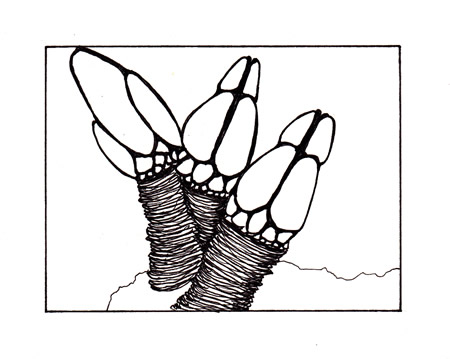
For the past two months, we started to experience daytime negative tides, a seasonal phenomenon where the tide becomes low enough to allow tidepool visitors to see organisms that are normally covered in water or inaccessible due to strong wave action. One of these creatures is the gooseneck barnacle (Mitella polymerus), a crustacean found living on the rocky Pacific coast in areas normally exposed to strong surf. Often living in colonies with dense populations in and around mussel beds, the gooseneck barnacle has a geographic range from Alaska to Baja California.
Part of the crustacean family, gooseneck barnacles average about four inches in length, have dark colored muscular, flexible, fleshy stalks (the peduncles) that is anchored to the rocks at one end. The other end is topped with the capitulum, made up of several cream colored plates which enclose the soft body that includes the intestines, stomach and long red colored featherlike legs. Omnivorous filter feeders, they extend their legs when covered with water to trap a variety of food such as small crustaceans, mollusks, plankton and detritus.

A hermaphrodite with both male and female sex organs, gooseneck barnacles usually do not self-fertilize. After producing eggs, a nearby barnacle extends its amazingly long penis into the female’s shell to release its sperm. Once fertilized, eggs are held in the mantle cavity for three to four weeks until the larvae are released into the ocean for approximately 1.5 months, where they grow and develop into juvenile barnacles and finally settle into a permanent home on a hard surface.
Thought to live over 20 years, predators of the gooseneck barnacle include birds, in particular certain species of gulls and the black oystercatcher, ochre sea stars, whelks (a type of snail) and possibly fish. Historically eaten as a delicacy in Spain and Portugal, they have been increasingly used as a food source in other cultures including our own. As a growing industry, they are lightly regulated and monitored and may be in danger of overharvesting. In addition, as with all other marine organisms, they are vulnerable to pollution and human disturbance.
The gooseneck barnacle derives its name from an historical misunderstanding. Centuries ago, people thought the creature was related to the European barnacle goose since the markings across the back of the goose was similar in appearance to a clump of gooseneck barnacles. Because the barnacle was often found on driftwood, people imaginatively assumed that geese developed from this invertebrate. As a result of this assumption and the belief that the goose evolved from fish, early Christians were happily able to eat barnacle geese on Fridays.
Local residents Mia Davidson and artist Jan Sattler are year round ocean swimmers who believe a better educated public will contribute to preservation of the marine habitat and its organisms.




